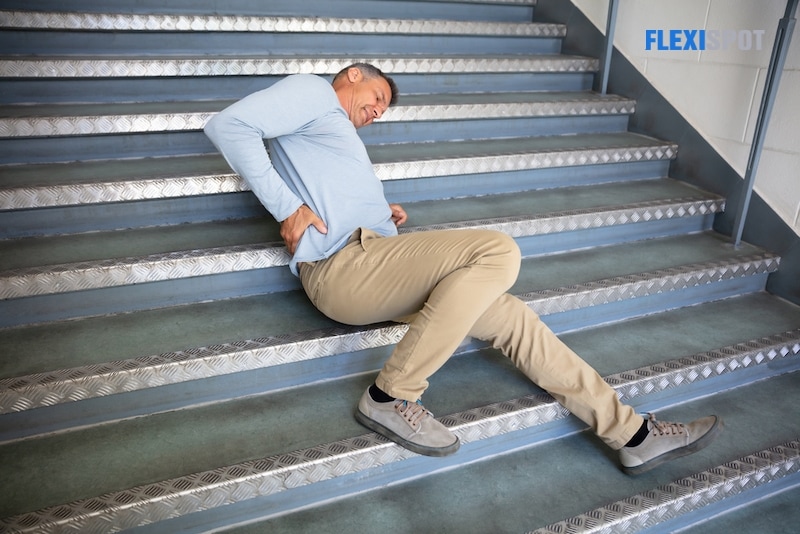Many of us who function at an office desk sit for at least 8 hours per day, or 40 hours per week. Sitting has become the most widespread posture in the workplace as digital technology has progressed. Most desk employees sit in front of a computer for an average of 10 hours per day, leaving little time for physical activity all through the day. And, sad to say, as we've all learned, sitting can be exceptionally harmful to your health—even much more than smoking, as some claim.
Humans are designed to be upright. Your heart and cardiovascular system will function more efficiently as a result. When you are erect, your bowel movements are also more efficient. It is prevalent in individuals who are bedridden in a hospital to experience difficulties with their bowel function. Your overall energy levels and endurance boost, and your bones retain their strength when you engage in physical activity.
The Sedentary Life
Every year, almost three million preventable deaths (or 6% of all fatalities) occur due to physical inactivity in the world. It is the fourth leading cause of noncommunicable disease-related death. It's also responsible for 27% of diabetes cases, 21–25% of breast and colon cancers, and roughly 30% of ischemic heart disease.
According to a poll, toddlers and preschoolers spend six hours a day doing some physical activity and an hour and a half watching television. As time passed, they spent less time engaging in physical exercise and more time engaging in screen-based hobbies. The 15–17-year-olds were the least likely to walk 12,000 steps per day, with only 7% achieving this objective. Younger children, ages 5–11, were significantly more likely to walk throughout the day.
According to the survey, young adults had the highest level of physical activity of all ages, with 53% of 18–24-year-olds being classified as adequately active. As people got older, they started to become less energetic. Those aged 75 and up had the lowest amount of exercise, averaging roughly 20 minutes of physical activity each day.
The Negative Outcomes
Many of us suffer from health problems that we blame on faulty genes, a poor diet, or even the surroundings. It's generally reasonable to conclude that our lifestyle habits contribute significantly to our health concerns. Here are a few of the issues that prolonged sitting can cause:
Weight Gain
It's no mystery that leading a sedentary lifestyle can result in weight gain. Sitting for long durations has been demonstrated to reduce lipoprotein lipase (LPL) activities, impairing the body's capacity to metabolize fat. This tends to increase fat storage and stimulates carbs (rather than fat) as a source of energy, causing the body to accumulate fat even on a low-calorie diet.
Risk of Heart Attack
According to a study, those who spend most of their days sitting are 54 percent more likely to have a heart attack. That's irrespective of other variables: We see it in both non-smokers and smokers. It can be seen in both regular exercisers and non-exercisers. Sitting is a danger factor in and of itself. Fundamentally, whether you exercise in the afternoons or eat a healthy diet all of the time, sitting non-stop every day at work will lead to an increased risk.
Neck and Back Issues
It's not simply that we sit during the day that causes difficulties; it's also how we sit. Over half of UK workers have experienced back discomfort, with one in every five taking time from work as a result. The forward head syndrome occurs when you slouch and lean into your computer, prompting your neck muscles to shorten and stiffen, producing migraines and arm problems. Bad posture also causes back problems by obliterating the natural s-shape of the spine.
Muscle Weakness
Sitting for long periods, the primary gluteal and leg muscles atrophy and waste away. These huge muscles assist you in walking and stabilizing yourself. When these muscles are weakened, you are more likely to get injuries from strains and falls when exercising.
Inadequate Blood Circulation
Poor circulation is another evident but sometimes overlooked side effect of sedentary sitting. Long periods of sitting can cause the pooling of blood in the legs and feet, resulting in varicose veins, swollen ankles, and even dangerous blood clots such as deep vein thrombosis (DVT).
Diabetes
According to a study examining the relationship between total sitting time and diabetes, physically inactive adults had an increased risk of developing diabetes, with extended sitting being a significant factor. This is because a reduction in muscle mass and strength can reduce insulin sensitivity, implying that cells communicate with insulin. This hormone regulates blood sugar levels more slowly. The lower the body's insulin sensitivity, the more likely it is to develop diabetes.
Heart Disease
Extended spells of sitting have been associated with cardiovascular disease. According to one study, those who watch over 23 hours of television each week have a 64% higher chance of dying from heart disease than people who watch only 11 hours a week. According to some specialists, those who are sedentary and sit for long periods have a 147% increased chance of having a heart attack or stroke.
Posture Issues
Prolonged sitting and slouching produce several difficulties for your shoulders, neck, back, and pelvis, in addition to leaving our muscles more sensitive to degeneration. Suppose you don't utilize an ergonomic chair or have an improper posture, to begin with; your neck and shoulders curve and tighten. In that case, your spine loses flexibility as it bears pressure, and your pelvis turns in the wrong direction.
Kidney Disease
Chronic kidney disease occurs when the kidneys cannot filter blood correctly, causing waste to build up in the body and, subsequently, renal failure. According to a study, women could reduce their chances of chronic kidney disease by sitting for shorter hours each day. When they reduced sitting time from 8 to 3 hours per day, this risk dropped by more than 30%. Men, too, observed a 15% reduction in their incidence of chronic kidney disease when they reduced the amount of time they spent sitting every day.
Cancer
The danger of lung, breast, uterine, colon, and endometrial cancers is by far the most frightening negative consequence of extended sitting. The exact cause of the link is unknown, although it could be because sedentary behavior increases insulin synthesis in the body, which promotes cell proliferation. Regular physical activity has an antioxidant impact in the body because it reduces oxidative stress. Weight gain, changes in hormone levels, metabolic disorders, and inflammation have all been related to an increased risk of cancer, all of which could be aggravated by sedentary behavior.
Body Pains
Chronic discomfort is more likely if you sit for lengthy periods with poor posture. Back pain is a widespread health issue in the United States, and it is one of the most common work-related illnesses. Over half of all adults in the United States suffer from musculoskeletal pain, including pain in the lower back, neck, joints, sciatica, and other problems, with 20.3 percent reporting lower back discomfort.
Mental Health Problems
We don't know as much about the links between sitting and psychological health as we do about the relationships between sitting and physical wellbeing. Still, we do know that people who sit a lot have a greater risk of anxiety and depression. This could be because those who spend a lot of time sitting miss out on the benefits of exercise and fitness. Spending most of the day on a computer or watching TV reduces sunlight exposure and social interaction, resulting in vitamin D insufficiency and feelings of isolation. If this is the case, getting up and moving can help.
Standing Up for Better Health
Spending less time sitting and more time standing is one obvious solution to ensure that you break the habit of sitting too much. Standing desks are steadily gaining traction, with major corporations such as Google, Twitter, AOL, and Facebook incorporating them into their workplaces.
Switching between sitting and standing at your workstation is another possibility. There's already a handful of height-adjustable standing desks available, which are way better than a fixed standing desk because they allow you to sit down and stand effortlessly. Check out these best-selling adjustable standing desks from one of the most trusted ergonomic solutions providers, FlexiSpot!
Eco-friendly bamboo desktop: Kana Pro Bamboo Standing Desk
Comes with large storage shelf: Esben Standing Desk UD5
Features glass or bamboo tabletop with spacious storage drawer: Comhar All-in-One Standing Desk
Click here to see FlexiSpot's wide range of ergonomic solutions and join upcoming exciting events!
Standing aids in staying in shape and discovering new ways to boost your everyday physical activity. It may take a bit of time to get accustomed to, but if it may help you avoid any health problems associated with sitting, it's well worth the time and effort. Let us strive to remember that we should work to live rather than the other way around.





